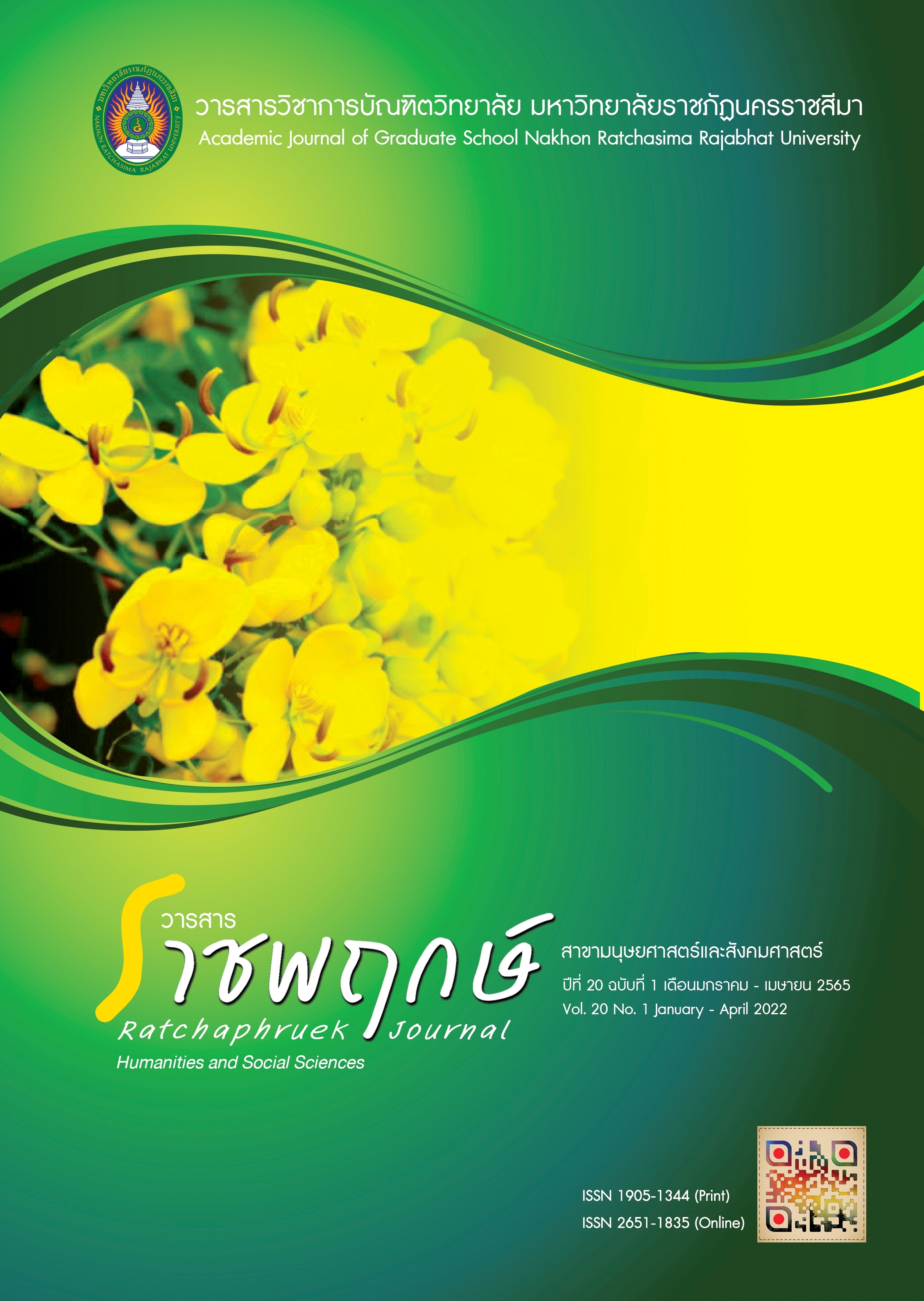Online Active Learning and Teaching for Teacher Education
Main Article Content
Abstract
According to the epidemic situation of COVID-19, online learning and teaching needs to be applied in all instructions. As a result, there are many problems of instruction. The writer of this article, as a lecturer of teacher students, there has a question “how online learning and teaching be effective?”. This leads to this academic article titled “Online Active Learning and Teaching for Pre-Service Teaching Education”. This academic article aimed to present new knowledge by analyzing and synthesizing the concepts of online learning and teaching and proactive learning using descriptive method. It was found that proactive online learning and teaching included 8 crucial parts: instructors, learners, learning and teaching policy, content, online teaching tools, appointment, additional learning sources, and teaching and learning activities that each section proposed the details of its own concrete operation. The part of teaching and learning activity was important for online active learning and teaching for teacher education students because of teachers and learners had to have activities together in class. There were 6 steps: Interest generation; Knowledge linkage; Description; Body of knowledge building; Group discussion; and Lesson summary.
Article Details

This work is licensed under a Creative Commons Attribution-NonCommercial-NoDerivatives 4.0 International License.
References
กรมอนามัย. (2562). รายงานสถานการณ์โควิด-19. สืบค้นเมื่อ 11 กรกฎาคม 2564, จาก https://covid19.anamai.moph.go.th/
ไชยยศ เรืองสุวรรณ. (2553). การออกแบบพัฒนาโปรแกรมบทเรียนและบทเรียนบนเว็บ (พิมพ์ครั้งที่ 15). มหาสารคาม: มหาวิทยาลัยมหาสารคาม.
ฐาปนีย์ ธรรมเมธา. (2557). อีเลิร์นนิง: จากทฤษฎีสู่การปฏิบัติ E-Learning: From theory to practice. นนทบุรี: สหมิตรพริ้นติ้งแอนด์พับบิสชิ่ง.
เทื้อน ทองแก้ว. (2563).การออกแบบการศึกษาในชีวิตใหม่: ผลกระทบจากการแพร่ระบาด COVID-19. คุรุสภาวิทยาจารย์ JOURNAL OF TEACHER PROFESSIONAL DEVELOPMENT, 1(2), น. 1-10.
พิมพ์พันธ์ เดชะคุปต์ และเยาว์ ยินดีสุข. (2560). ทักษะ 7C ของผู้สอน 4.0. กรุงเทพฯ:จุฬาลงกรณ์มหาวิทยาลัย.
เมธาวี จำเนียร และกรกฏ จำเนียร. (2561).ประโยชน์ ปัญหาและแนวทางแก้ปัญหาการใช้สื่อออนไลน์ในการเรียนอย่างมีประสิทธิภาพของโรงเรียนจังหวัดนครศรีธรรมราช. วารสารราชพฤกษ์, 16(3), น. 113-121.
เยาวเรศ ภักดีจิตร. (2557). Active Learning กับการพัฒนาผู้เรียนในศตวรรษที่ 21. นครสวรรค์: คณะครุศาสตร์ มหาวิทยาลัยราชภัฏนครสวรรค์.
วัชรี เกษพิชัยณรงค์ และน้ำค้าง ศรีวัฒนาโรทัย. (2555). การเรียนเชิงรุกและเทคนิคการจัดการเรียนการสอนที่เน้นการเรียนเชิงรุกการอบรมเรื่องการเรียนการสอนเชิงรุก. ปทุมธานี: มหาวิทยาลัยกรุงเทพ.
วิทยา วาโย, อภิรดี เจริญนุกูล, ฉัตรสุดา กานกายันต์ และจรรยา คนใหญ่. (2563). การเรียนการสอนแบบออนไลน์ภายใต้สถานการณ์แพร่ระบาดของไวรัส COVID-19: แนวคิดและการประยุกต์ใช้จัดการเรียนการสอน. วารสารศูนย์อนามัยที่ 9, 14(34), น. 285-298.
สยมพร ศิรินาวิน. (2563). โควิด-19: ความรู้สู่การปฏิบัติ พัฒนาการปฏิบัติ. นนทบุรี: สำนักงานคณะกรรมการสุขภาพแห่งชาติ.
เสถียร พูลผล และปฏิพล อรรณพบริบูรณ์. (2563). การสำรวจความคิดเห็นของนักศึกษาเภสัชศาสตร์ที่มีต่อการเรียนการสอนออนไลน์ในช่วงโควิดเพื่อออกแบบแนวทางการจัดการเรียนรู้รูปแบบใหม่ของคณะเภสัชศาสตร์ มหาวิทยาลัยสยาม. ใน หนังสือประมวลบทความในการประชุมวิชาการ ครั้งที่ 15 (น. 36-47). กรุงเทพฯ: สมาคมเครือข่ายการพัฒนาวิชาชีพอาจารย์และองค์กรระดับอุดมศึกษา แห่งประเทศไทย (ควอท) และสำนักงานปลัดกระทรวงการอุดมศึกษา วิทยาศาสตร์ วิจัยและนวัตกรรม.
อมรเทพ เทพวิชิต. (2552). คู่มือการใช้ Moodle. นครราชสีมา: ศูนย์นวัตกรรมและเทคโนโลยีการศึกษา มทส.
อาณัติ รัตนถิรกุล. (2553). สร้างระบบ E-Learning ด้วย Moodle ฉบับสมบูรณ์. กรุงเทพฯ: เอช.เอ็น.กรุ๊ป.
อาภรณ์ ใจเที่ยง. (2553). หลักการสอน (พิมพ์ครั้งที่ 5). กรุงเทพฯ: โอ.เอส.พริ้นติ้งเฮาส์.
โอภาส เกาไศยาภรณ์, วสันต์ อติศัพท์ และอนุชิต งามขจรวิวัฒน์. (2560). การออกแบบการเรียนการสอนอีเลิร์นนิ่ง: รายการตรวจสอบ. กรุงเทพฯ: นีโอพ้อยท์.
Baldwin, J. & Williams, H. (1988). Active learning: a trainer's guide. Oxford: Blackwell.
Bonwell, C. C. & Eison, J. A. (1991). Active learning: creating excitementin the classroom. Washington DC: The Washington University.
Johnson, H. & Johnson, P. (1991). Task knowledge structures: Psychological basis and integration into system design. Act psychological, 78(1-3), pp. 3-26.
Harvard University. (2018). Active learning. Retrieved July 11, 2021, from, https://bokcenter. harvard.edu/ active-learning
Khan, B. H. (2011). User Interface design for virtual environments: challenges and advances. PA: IGI Global.
Michael, J. A. & Modell, H. I. (2003). Active learning in secondary and college science classrooms: A working model for helping the learner to learn. New York: Routledge.
Shenker, J. I. & Bernstein, D. A. (1996). Instructor's Resource Manual for Psychology: Implementing Active Learning in the Classroom. Boston: Allyn & Bacon.
Silberman, M. (1996). Active learning: 101 strategies to teach any subject. Boston: Allyn & Bacon.


